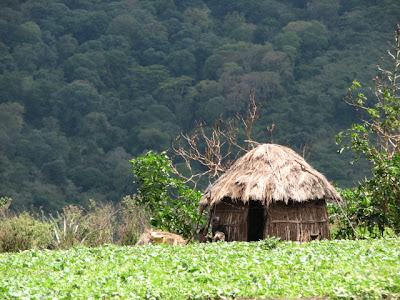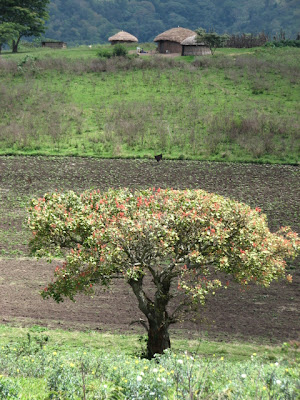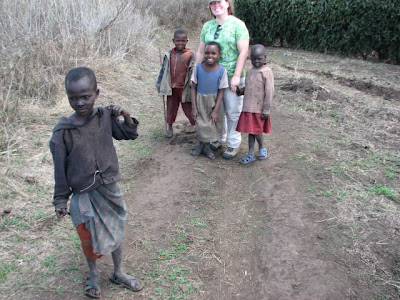In my last post, I described a day trip K2 and I took to Monduli, about an hour's drive from Arusha. This past weekend, Anna and I went back to Monduli and took a longer look around, with K2 joining us on Sunday.
Anna's and my first stop was Meserani Snake Park. Anna doesn't like snakes, but these are (almost) all inside glass-fronted cages, so it was safe to take a look. We almost didn't go in, though, because the posted price was $10.00 U.S. or 13,000 T shillings. The park is interesting, but we weren't going to pay that much! But wait-- Anna has a former classmate and friend who is a nationally recognized herpetologist who previously worked at the snake park and knows everybody there. She called him from her cell phone and told him of our plight. He talked to the receptionist, who then let us in for 1,000 T shillings each. That's more like it!
We toured the collection of snakes behind glass. Tanzania hosts an impressive array of deadly snakes, and a few that are not dangerous.
Puff Adder: deadly poisonous (K2 told us a scary puff adder story the next day...stay tuned for that).
Green Mamba: the world's most poisonous snake. Looks just like a vine when you're walking through the forest.
Black Mamba: deadly poisonous. It's not quite black on the outside, more dark gray. It's called black because the inside of its mouth is inky black and that's the last thing you see before you die. The guide told us all of the other snakes are not aggressive, but this one is aggressive and more likely to strike if you happen across it. To the left of the snake, you can see chunks of recently-shed skin.
Python: not poisonous, will instead kill you by crushing you in its coils. I doubt that happens often for humans, but next to the cage, they had taped up an old news story with pictures of a man who was swallowed by a python. Just to the left of the snake's head, you can see the skin starting to peel for the next shed.
A flowerpot full of not-dangerous brown house snakes. Just don't let it be my house...
Here's where they had a non-dangerous snake you could drape around your neck to pose for pictures. This boy did it, but most of his classmates wouldn't. When they asked the teacher if she wanted to, she gave an immediate, emphatic, "Uh uh!" I did it, but Anna also said, "Uh uh."
We saw a few reptiles with legs, too. Anna told me snakes freak her out, but if the animal has legs, then it's OK. Except for millipedes.
Nile Crocodile.
Nile Monitor Lizard.
And the much bigger Savanna Monitor.
Crap! He saw us!
Something's rising out of the murky depths...will it have legs or not?
No worries--just some cute little terrapins with their four legs.
This millipede was not inside the Snake Park, it was on Pemba Island in 2008. But here it is, to illustrate the whole issue of not enough legs versus too many legs and who's creepy and who's not.
Anna had just finished telling me a disgusting story about millipedes and pit toilets (or "long drop" toilets, if you're British), and then we saw this.
And finally, the soothing part of the Snake Park-a garden including trees in bloom and birdfeeders and no reptiles.
Flamboyant tree blossoms.
Guinea fowl among the fallen flamboyant petals.
Flamboyant trees outside the park's wall.
Our next stop was at the Meserani Oasis for lunch.
The Oasis is a restaurant, bar, and campground where overland trucks taking tourists on long, rugged trips frequently stop. This day, it was quiet.
Wash your hands (at the handwashing station on the left) before you have that shot of vodka.
A few locals were inside having drinks, but we couldn't figure out where they came from. Ours was the only car in the parking lot...
...and the surrounding countryside looked like this.
We were the only customers eating...
...except for these goats making a meal of bougainvillea.
Who, me?
Then we drove on to the tiny, charming town of Monduli and checked into Emanyatta Lodge.
But after a Canadian woman tipped us off that she had been bitten by mosquitoes in our very room two nights before, we transferred to "Maasai Tower," where the rooms include mosquito nets.
We started out in one of these cute pseudo-Maasai bungalows. It had no mosquito net, but the receptionist/cook/waitress assured us there are no mosquitoes in Monduli.
Later on, we discovered that the water heater didn't work in the new room. The receptionist/cook/waitress helped us out by bringing us buckets of hot water for a "bucket bath," and then gave us the key to another room we could use for hot showers the next morning.
The lodge website promises five tours, some of multiple days, that they will arrange for you. We asked the receptionist/cook/waitress to arrange a guide to take us hiking in the hills the next day. She went off to her office for ten minutes, then came back and said the guide had gone to Arusha and no guide was available in Monduli. Hmmm....
We headed out for a stroll around town. Perhaps we'd find a "cultural tourism" office? A couple of blocks away from the lodge, a car pulled up and stopped, the driver rolled down the window and called out, "Anna! Hello!" Anna must have a lot of Tanzanian friends, because this is the second time this has happened to us in a little town away from Arusha. The driver of the car, who works at a lodge in Arusha, is from Monduli. His brother Peter, also in the car, is a tour guide. Peter stepped out of the car, shook our hand, and signed us up for a hiking tour for the next morning. Sometimes in Tanzania, things just work out. Either that, or Anna is a heck of a "visitor coordinator!"
Our stroll around Monduli was really pleasant, too. People mostly ignored us or greeted us politely. As opposed to Arusha, where we would've had many calls of "mzungu" echoing after us.
A few jacarandas were still blooming up in Monduli.
Hey! Maybe the lodge could offer tractor rides as an activity!
People here are strong supporters of CCM, the ruling political party. Here's a campaign khanga from the recent national elections. We saw many people wearing CCM khangas, hats, and shirts.
Traditional-style houses of mud construction.
Carrying home a new mattress on a motorcycle.
Back at the lodge, where the website promises dinner is served from 6:00 to 10:00, we ordered early (because the Canadian woman advised it). No menu, but from our extensive knowledge of Tanzanian cuisine, we requested beef stew and rice at 7:00. The receptionist/cook/waitress agreed to the stew, but bartered for 8:00. We retired to our tower room for the two-hour wait. The television offered just one channel, on which we watched birthday greetings followed by death memorials, all in Swahili. The TV's in the guest rooms were apparently not hooked up to the huge satellite dish next to the restaurant/ local sports bar, where groups of men had earlier been watching English soccer matches and having a few beers.
But right at 8:00, dinner was ready and it was quite good. We settled in as the only customers in this cavernous, round space with a cement floor and walls, soaring thatched roof supported by black-and-white striped metal posts, scattered tables, and three big screen TV's. The TV's were broadcasting highland games from South Africa, so Scottish Anna had her fill of men in kilts while we ate. I have to admit that watching a big African man in a plaid skirt hoist a giant rock onto a flatbed truck was marginally more interesting than the birthday notices. But just as odd.
Next morning, with breakfast promised from 7:00 to 10:00, the receptionist/cook/waitress appeared at about 8:00. She sent an assistant on a grocery run into town and then prepared toast and eggs. Meanwhile, K2 and Peter, our guide, were on their way from Arusha with three box lunches and instructions to meet us at 9:00. They showed up promptly, and waited for us to finish eating.
We headed for Monduli Ju, up in the hills. Peter grew up there and is Maasai, so he was a great choice for guide (although I can't really say we "chose" him). We started the tour by parking Anna's car outside Peter's mother's house and setting off on foot into a beautiful green valley with a traditional Maasai village at the far end.
The Maasai's main business is cattle, so we saw several bands during our hike.
The Toyota Corolla of the Maasai: affordable, reliable, ubiquitous. Useful for hauling water cans.
The Maasai's main business is cattle, so we saw several bands during our hike.
Peter and Anna and the Giant Savanna Asparagus. OK, not really. It's a sisal plant.
We stumbled across this beautiful, big grasshopper...
...even more beautiful with his wings open.
And then these less beautiful, but really interesting dung beetles.
Here's an action-packed video of their dung-rolling technique. One rests while the other pushes the ball, then they switch off.
Approaching the village.
Anna in Maasai land. Not sure what Peter's up to back there...
Me, Anna, and Peter up on top...
...where we had a great view back down to Monduli town.
...even more beautiful with his wings open.
And then these less beautiful, but really interesting dung beetles.
Here's an action-packed video of their dung-rolling technique. One rests while the other pushes the ball, then they switch off.
Approaching the village.
Anna in Maasai land. Not sure what Peter's up to back there...
We sat in the grass in the village while Peter, who knows everyone here, explained some Maasai traditions to us. Right here, I'm leaving out a really cute picture of a group of small children who stood and watched us until I pointed my camera at them. They ran away laughing just as the shutter clicked (or whatever a digital camera does). They were laughing, but they did run away, so I take that to mean they wouldn't want their picture in my blog. Three older women approached to shake our hands and greet us. Two older men sat nearby and kept an eye on us.
A village dog.
Baby goat with a bell and cropped ears. Livestock owners clip the animals' ears in different patterns to denote ownership. They also use brands.
This Corolla--er, donkey also has clipped ears...
...but in a different pattern for a different owner.
We passed through the village and climbed the small ridge behind it.
Me, Anna, and Peter up on top...
...where we had a great view back down to Monduli town.
We walked past another small village and farm fields in such a serene setting that I found myself wanting to move into the village, until I saw a resident carrying a jerry can of water from somewhere.
 | ||
We followed the ridge on around to our starting point.
A handsome billy goat along the trail.
Peter and K2 headed back to the village of Monduli Ju and lunch at Peter's mother's house (or Mama Peter, as they say in Tanzania).
Anna, K2 and I settled down in the yard outside Mama Peter's house with our nice box lunches from town. Peter went inside and came back out with a plate of ugali and spinach prepared by his mother. Ugali is a stiff corn mush. Peter's meal was a favorite Tanzanian everyday lunch, while K2's fried chicken was aimed more at tourists. Poor K2! He was so jealous of Peter's chakula kwa mama (food from Mama). An especially large chicken kept scratching around between us, looking for crumbs. At one point it flew over Anna's head with much flapping and crowing.
These two were playing nearby. They were the first people all day willing to have their picture taken, so here they are!
We set off on foot up the main road. More cows...
As we passed another village, several children ran out and grabbed my hands, then walked along with me, clutching my hands and rubbing my arms. They seemed to be curious about my skin. Notice the outfit in front of Maasai shuka with hoodie. When K2 pointed the camera at us, one little boy ducked behind me and a few others ran back to the village to avoid being photographed.
We walked off the road into excellent snake habitat of tall dry grass. This was on my mind and Anna's because of our recent visit to the snake park. But Peter, the local, was totally unconcerned, so we followed him to a beautiful spot where we all lounged and enjoyed the scenery while K2 told jokes and said he had a scary story to tell us, "but not until we leave this grass."
Earlier, Peter had explained to us that young boys (pre-circumcision age of 13-15) are responsible for herding cattle. A group of cowherds were standing nearby, leaning on their sticks and watching us. Traditional Maasai are polygamous. Peter told us all these boys are from the same father, but with more than one mother. I tried hard not to get any of them into my pictures as I swung the camera around.
Until I realized that this one was jumping into every picture just as I snapped them. I asked in Swahili if they wanted a picture and they all formed up in a nice pose with only a little bit of coaching.
When they gathered around to see their picture on the digital screen, Peter translated that they said, in Maasai, "Look, you can see our cows behind us."
And here are the well-tended cows.
Okay, everybody stand down.
Eventually, we had to get up and leave this beautiful spot. As we stepped out of the tall grass back onto the road, K2 made good on his promise of a scary story. When he was 10 years old, he was playing in a field of tall grass. He saw a fruit tree and stepped over to it. He stretched up to reach the fruit, and noticed that the ground under his feet felt soft and spongy. But he was concentrating on picking fruit and kept stretching upwards, even bouncing a little on that spongy ground. Then he heard a hiss, looked down, and saw that he was standing on a puff adder! He jumped a few feet straight up into the air and ran out of the grass with no fruit, but also with no snake bite.
And on that note, we trekked back to Anna's car and piled in for the drive home.












































































As usual, I loved your post and photos, Barbara. I loved the Maasai boys' pride in their cows. And I loved the dung beetles! Go figure... Thank you!
ReplyDelete